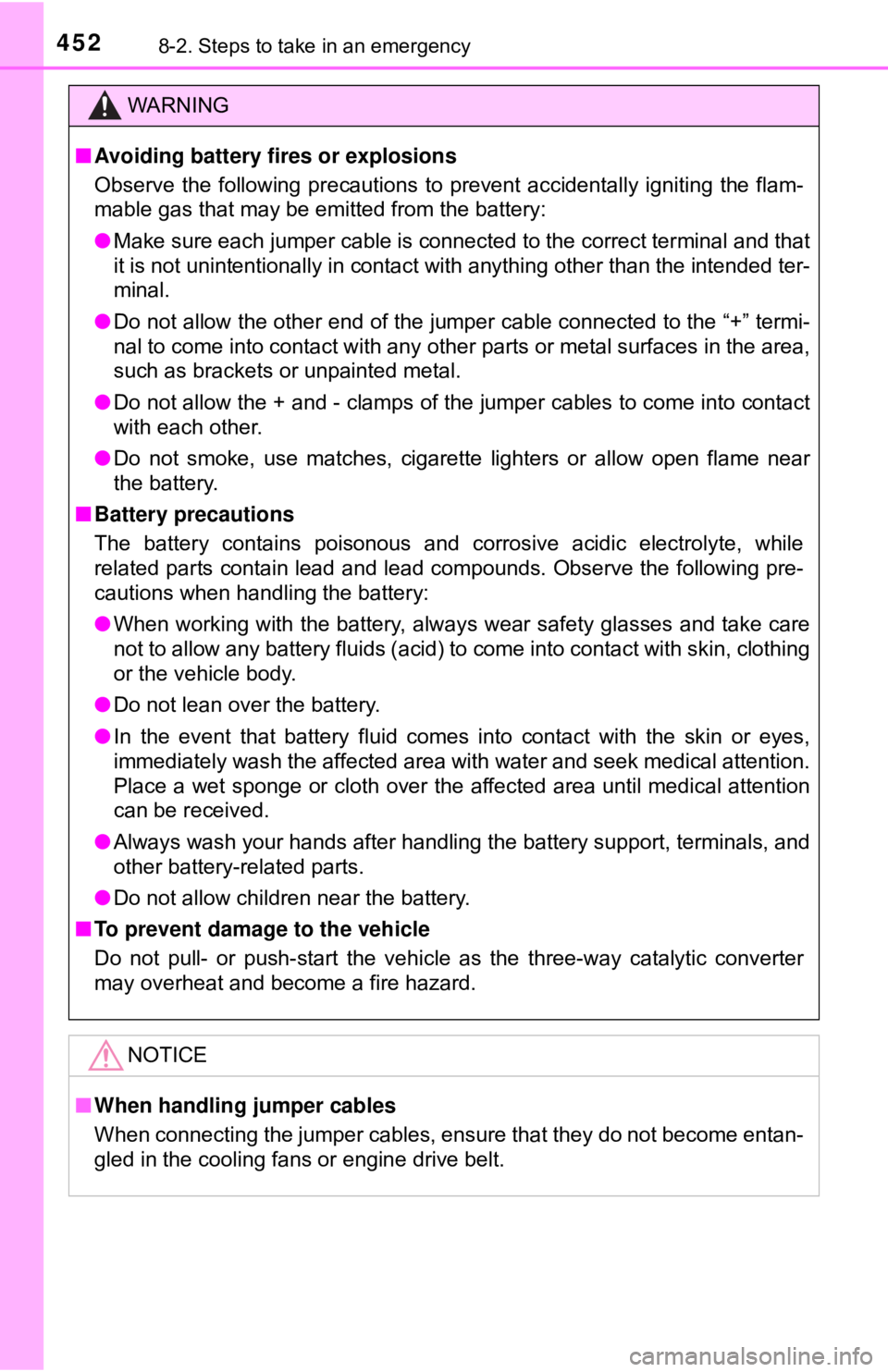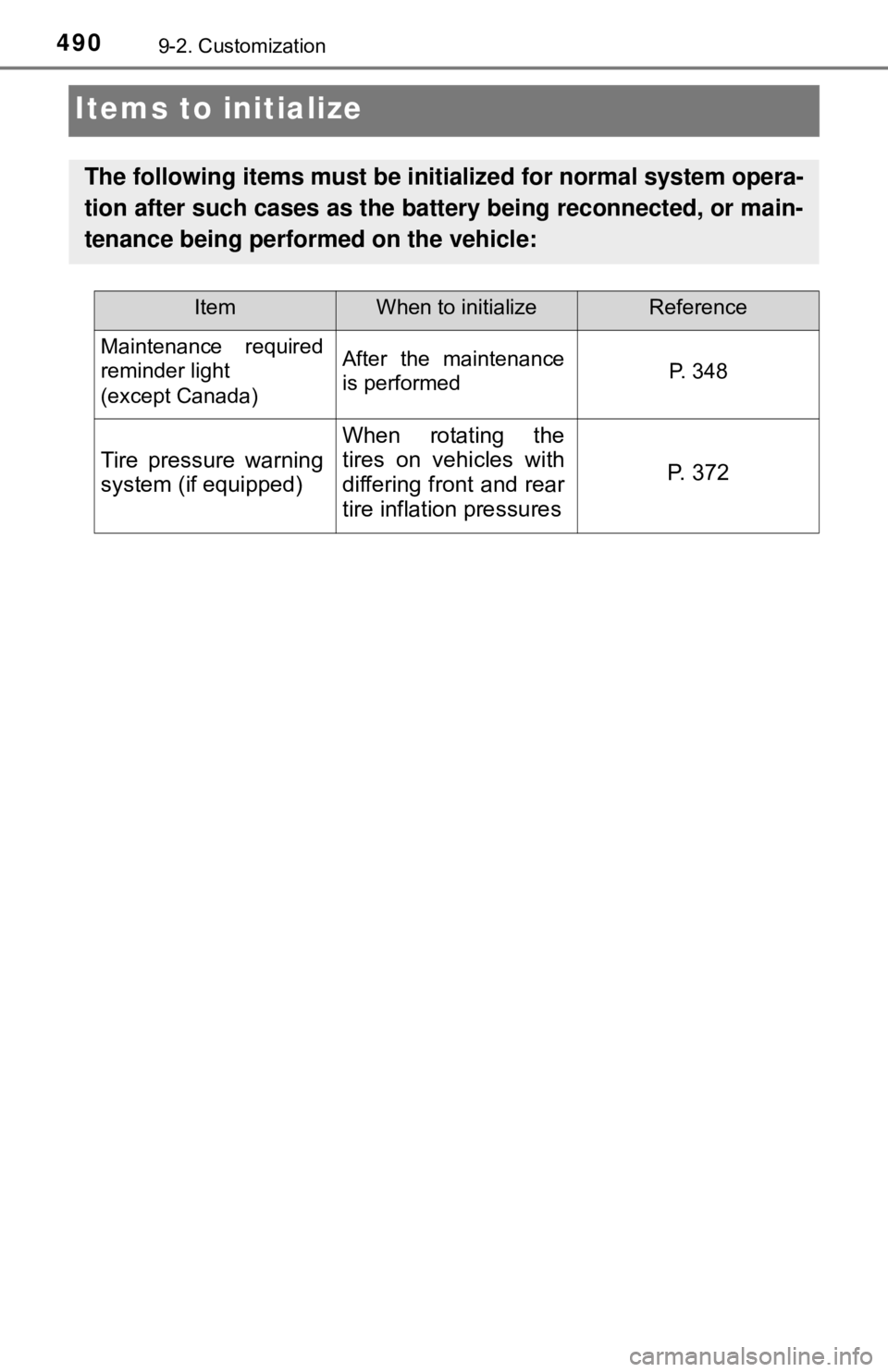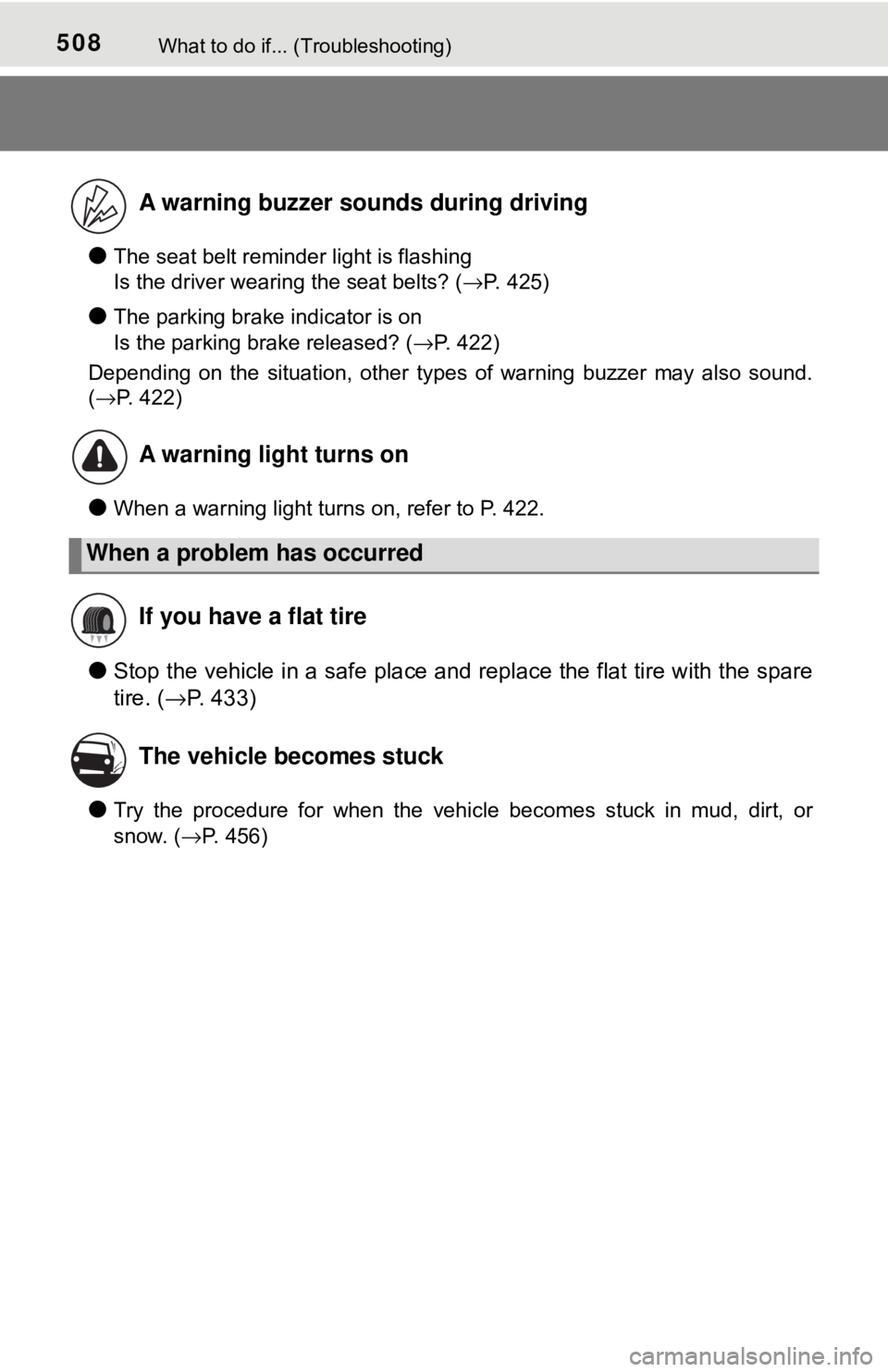2018 TOYOTA YARIS HATCHBACK warning light
[x] Cancel search: warning lightPage 431 of 520

4318-2. Steps to take in an emergency
8
When trouble arises
WARNING
■Maintenance of the tire (vehicles with a tire pressure warning sys-
tem)
Each tire, including the spare (if provided), should be checked monthly
when cold and inflated to the inflation pressure recommended by the
vehicle manufacturer on the vehicle placard or tire inflation pressure
label (tire and load information label). (If your vehicle has tires of a dif-
ferent size than the size indicated on the vehicle placard or tire inflation
pressure label [tire and load information label], you should determine
the proper tire inflation pressure for those tires.)
As an added safety feature, your vehicle has been equipped with a tire
pressure monitoring system (TPMS-ti re pressure warning system) that
illuminates a low tire pre ssure telltale (tire pressure warning light) when
one or more of your tires is significantly under-inflated. Accordingly,
when the low tire pressure telltale (tire pressure warning light) illumi-
nates, you should stop and check your tires as soon as possible, and
inflate them to the proper pressure. Driving on a significantly under-
inflated tire causes the tire to overheat and can lead to tire failure.
Under-inflation also reduces fuel effi ciency and tire tread life, and may
affect the vehicle’s hand ling and stopping ability.
Please note that the TPMS (tire pressure warning system) is not a sub-
stitute for proper ti re maintenance, and it is the driver’s responsibility to
maintain correct tire pressure, even if under-inflation has not reached
the level to trigger illumination of the TPMS low tire pressure telltale (tire
pressure warning light).
Your vehicle has also been equipped with a TPMS (tire pressure warn-
ing system) malfunction indicator to indicate when the system is not
operating properly. The TPMS (tire pressure warning system) malfunc-
tion indicator is combined with the lo w tire pressure telltale (tire pressure
warning light). When the system detects a malfunction, the telltale will
flash for approximately one minute and then remain continuously illumi-
nated. This sequence w ill continue upon subsequ ent vehicle start-ups
as long as the malfunction exists. When the malfunction indicator is illu-
minated, the system may not be able to detect or signal low tire pres-
sure as intended.
TPMS (tire pressure warning system) malfunctions may occur for a vari-
ety of reasons, including the installation of replacement or alternate tires
or wheels on the vehicle that prevent the TPMS (tire pressure warning
system) from functioning properly. Always check the TPMS (tire pres-
sure warning system) malfunction te lltale after replacing one or more
tires or wheels on your vehicle to ensure that the replacement or alter-
nate tires and wheels allow the TPMS (tire pressure warning system) to
continue to function properly.
Page 444 of 520

4448-2. Steps to take in an emergency
■The compact spare tire
●The compact spare tire is identified by the label “TEMPORARY USE
ONLY” on the tire sidewall.
Use the compact spare tire temporarily, and only in an emergency.
●Make sure to check the tire inflation pressure of the compact spare tire.
(→ P. 469)
■After completing the tire change (vehicles with a tire pressure warn-
ing system)
The tire pressure warning system must be reset. ( →P. 372)
■When using the compact spare tire (vehicles with a tire pressure
warning system)
As the compact spare tire is not equipped with a tire pressure warning
valve and transmitter, low inflation pressure of the spare tire will not be
indicated by the tire pressure warning system. Also, if you replace the
compact spare tire after the tire pressure warning light comes on, the light
remains on.
■When the compact spare tire is equipped
The vehicle height may become lower when driving with the compact
spare tire compared to when driving with standard tires.
■If you have a flat front tire on a road covered with snow or ice
Install the compact spare tire on one of the rear wheels of the vehicle.
Perform the following steps and fit tire chains to the front tires:
Replace a rear tire with the compact spare tire.
Replace the flat front tire with the tire removed from the rear of the
vehicle.
Fit tire chains to the front tires.
1
2
3
Page 452 of 520

4528-2. Steps to take in an emergency
WARNING
■Avoiding battery fires or explosions
Observe the following precautions to prevent accidentally igniting the flam-
mable gas that may be emitted from the battery:
● Make sure each jumper cable is connected to the correct terminal and that
it is not unintentionally in contact with anything other than the intended ter-
minal.
● Do not allow the other end of the jumper cable connected to the “+” termi-
nal to come into contact with any other parts or metal surfaces in the area,
such as brackets or unpainted metal.
● Do not allow the + and - clamps of the jumper cables to come into contact
with each other.
● Do not smoke, use matches, cigarette lighters or allow open flame near
the battery.
■ Battery precautions
The battery contains poisonous and corrosive acidic electrolyte, while
related parts contain lead and lead compounds. Observe the following pre-
cautions when handling the battery:
● When working with the battery, always wear safety glasses and take care
not to allow any battery fluids (acid) to come into contact with skin, clothing
or the vehicle body.
● Do not lean over the battery.
● In the event that battery fluid comes into contact with the skin or eyes,
immediately wash the affected area with water and seek medical attention.
Place a wet sponge or cloth over the affected area until medical attention
can be received.
● Always wash your hands after handling the battery support, terminals, an\
d
other battery-related parts.
● Do not allow children near the battery.
■ To prevent damage to the vehicle
Do not pull- or push-start the vehicle as the three-way catalytic conver\
ter
may overheat and become a fire hazard.
NOTICE
■When handling jumper cables
When connecting the jumper cables, ensure that they do not become entan-
gled in the cooling fans or engine drive belt.
Page 453 of 520

4538-2. Steps to take in an emergency
8
When trouble arises
If your vehicle overheats
●The high engine coolant temperature warning light ( →P. 422)
comes on or flashes, or a loss of engine power is experienced. (For
example, the vehicle sp eed does not increase.)
● Steam comes out from under the hood.
Stop the vehicle in a safe place and turn off the air conditioning sys-
tem, and then stop the engine.
If you see steam:
Carefully lift the hood after the steam subsides.
If you do not see steam:
Carefully lift the hood.
After the engine has cooled
down sufficient ly, inspect the
hoses and radiator core (radia-
tor) for any leaks.
Radiator
Cooling fan
If a large amount of coolant leaks,
immediately contact your Toyota
dealer.
The coolant level is satisfactory
if it is between the “FULL” and
“LOW” lines on the reservoir.Reservoir
“FULL”
“LOW”
Radiator cap
The following may indicate that your vehicle is overheating.
Correction procedures
1
2
3
1
2
4
1
2
3
4
Page 489 of 520

4899-2. Customization
9
Vehicle specifications
■Automatic light off system* (→ P. 156)
*: Vehicles with daytime running lights
■
Daytime running lights* ( → P. 158)
*: If equipped
■
Seat belt reminder buzzer ( →P. 425)
FunctionDefault settingCustomized
setting
Time elapsed before head-
lights automatically turn off
after doors are closed 30 seconds0 seconds
OO
60 seconds
90 seconds
12
FunctionDefault settingCustomized
setting
Daytime running light sys-
tem (except for Canada) On OffOO
12
FunctionDefault settingCustomized
setting
Vehicle speed linked seat
belt reminder buzzer On Off—O
WARNING
■
During customization
As the engine needs to be running during customization, ensure that the
vehicle is parked in a place with adequate ventilation. In a closed area such
as a garage, exhaust gases including harmful carbon monoxide (CO) may
collect and enter the vehicle. This may lead to death or a serious health
hazard.
NOTICE
■During customization
To prevent battery discharge, ensure that the engine is running while cus-
tomizing features.
12
Page 490 of 520

4909-2. Customization
Items to initialize
The following items must be initialized for normal system opera-
tion after such cases as the battery being reconnected, or main-
tenance being performed on the vehicle:
ItemWhen to initializeReference
Maintenance required
reminder light
(except Canada)After the maintenance
is performedP. 348
Tire pressure warning
system (if equipped)
When rotating the
tires on vehicles with
differing front and rear
tire inflation pressures
P. 3 7 2
Page 508 of 520

508What to do if... (Troubleshooting)
●The seat belt reminder light is flashing
Is the driver wearing the seat belts? (→P. 425)
●The parking brake indicator is on
Is the parking brake released? (→P. 422)
Depending on the situation, other types of warning buzzer may also sound.
( →P. 422)
●When a warning light turns on, refer to P. 422.
●Stop the vehicle in a safe place and replace the flat tire with the spare
tire. ( →P. 433)
●Try the procedure for when the vehicle becomes stuck in mud, dirt, or
snow. ( →P. 456)
A warning buzzer sounds during driving
A warning light turns on
When a problem has occurred
If you have a flat tire
The vehicle becomes stuck
Page 509 of 520

509Alphabetical index
Alphabetical index
A/C ............................................ 318Air conditioning filter ............. 385
Manual air conditioning system ......... ....................... 318
ABS (Anti-lock Brake System) .................................. 215 Function ................................ 215
Warning light ......................... 423
Air conditioning filter .............. 385
Air conditioning system.......... 318 Air conditioning filter ............. 385
Manual air conditioning system ......... ....................... 318
Airbags ....................................... 36 Airbag operating conditions .... 44
Airbag precautions for your child .............................. 39
Airbag warning light .............. 423
Correct driving posture ........... 26
Curtain shield airbag operating conditions ............. 44
Curtain shield airbag
precautions ........................... 39
Front passenger occupant classification syst em............. 49
General airbag precautions .... 39
Locations of airbags................ 36
Modification and disposal of airbags ............... 43
Side airbag operating conditions ............................. 44
Side airbag precautions .......... 39
Side and curtain shield airbags operating
conditions ............................. 44
Side and curtain shield airbags precautions .............. 39
SRS airbags............................ 36 Anchor brackets ........................ 59
Anti-lock Brake System
(ABS) ...................................... 215
Function ................................ 215
Warning light......................... 423
Assist grips .............................. 338
Audio input
*............................ 232
Audio remote control switches
*............................... 231
Audio system
*......................... 229
Antenna ................................ 246
Audio input............................ 232
Audio settings ....................... 238
AUX port/USB port ............... 232
Bluetooth
® audio .................. 276
CD player.............................. 247
Display settings .................... 239
General settings ................... 236
iPod ...................................... 253
MP3/WMA disc ..................... 247
Portable music player ........... 262
Radio .................................... 245
Setup menu .......................... 235
USB memory ........................ 257
Voice settings ....................... 240
Automatic High Beam ............. 196
Automatic transmission ......... 149 If the shift lever cannot be
shifted from P ..................... 151
AUX port
*................................. 232
A
*: For vehicles with Entune Audio Plus,
refer to the “MULTIMEDIA SYSTEM OWNER’S MANUAL”